Distance Education
distance education programs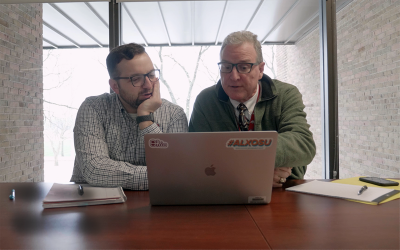
Services
Our services are funded through the university's distance education budget model, which means the support and services listed below are funded by enrollments in online programs.
Administrative Support
Start here! Consultations with our experienced staff can help you decide what programs are good candidates for distance education programs. We can provide market and competitor insights to help determin program viability and anticipated enrollment. We'll guide you through the program approval process and coordinate with stakeholders across campus to ensure online programming is integrated into university planning. We're constantly working with you, listening to your feedback and representing program interests to university leadership and student support units.
Course Design
Our instructional designers work closely with your faculty to develop the online courses that are part of your program, providing them with tools, templates and resources to develop and support their courses while infusing best practices and academic integrity. Our video and multimedia team helps develop professional course introduction videos and other assets.
LEARN MORE ABOUT COURSE DESIGN
State Authorization
Our state authorization team is dedicated to researching distance education and professional licensure regulations, seeking and maintaining compliance, and communicating changes in authorization status.
LEARN MORE ABOUT STATE AUTHORIZATION
Marketing
Our marketing team conducts market research and works with you and your college's marketing team to promote your program under the Ohio State Online sub-brand using tactics like paid advertising and content marketing.
Take the first step toward developing your online program.
Contact us to schedule a consultation.
Guiding Principles
The guiding principles of Ohio State's distance education programs are value, quality and rigor. These distinguish us in the competitive field of distance education.
Value
Focusing on the differentiating factors of our degrees when communicating to potential students will clearly mark the value of an Ohio State online degree. These differentiating factors have earned Ohio State Online consistently high U.S. News and World Report’s Best Online Programs rankings year after year.
Our focus is on programs that are available 100% at a distance. This enables us to serve a larger set of potential students who may not be able to come to campus due to work or life commitments. The courses are developed in collaboration between Ohio State’s nationally recognized faculty and our instructional design experts.
Quality
It is essential that we uphold the integrity and quality of an Ohio State degree. Students are held to the same high admissions standards, and the caliber of student admitted to our distance programs is equal to that of our on-campus programs.
Rigor
Consistent, rigorous course experiences both on-campus and at a distance are what produce students who are prepared for their future careers. Unlike many competitors that house distance faculty in a distance college and hire many of their instructors on a temporary or term-by-term basis, Ohio State Online students are taught by the same faculty from the same colleges as their on-campus peers and are held to the same rigorous course standards.
Definitions
Ohio State has adopted the Higher Learning Commission's distance education definitions.
The University Registrar defines distance courses and programs as follows:
Distance Course
A distance course is one in which 75% or more of formalized instruction, synchronous or asynchronous, uses one or more of the following technologies: the internet; one-way and two-way transmission through open broadcast, closed-circuit, cable, microwave, broadband lines, fiber optics, satellite, or wireless communication devices; audio conferencing; or videocassettes, DVDs, and CD-ROMs used in conjunction with any of the other technologies.
Ohio State defines distance courses by two instruction modes:
- Distance Learning (DL): 100% of instruction is offered by distance
- Distance Enhanced (DH): 75%-99% of instruction is offered by distance
View the University Registrar's Job Aid for Class Labels.
Distance Program
A distance program is a postsecondary educational program offered by an institution of higher learning, in which 50% or more of the courses offered are distance courses, which leads to an academic or professional degree, certificate, or other recognized educational credential.
An associates, bachelor’s, master’s or doctoral program is considered a distance program if 50% or more of the courses offered are distance courses. Ohio State does not include minors or embedded certificates as stand-alone education credentials for distance education; however, Certificate Types 1A, 2 and 3A can be considered distance programs if 50% or more of the courses offered are distance courses.
Why Definitions and Labels Matter
The consistent use of labels with distance education programs, courses and students is critical for compliance requirements, accreditation reporting, and clear and effective consumer information.
Students enrolled in Ohio State Online programs are identified by the ONL (online learning) subplan in the student information system (SIS). The distance education budget model is applied to all Distance Learning (DL) and Distance Enhanced (DH) credit hours for students enrolled in the ONL subplan.
Business Model
When we talk about Ohio State’s business model for distance education, we’re really referring to two separate financial models: the tuition model – what students pay for distance education – and the budget model – how that revenue is distributed across the university.
These financial models were approved by the Office of Academic Affairs and the University Senate Fiscal Committee in 2013 and are reevaluated on a yearly basis. These models only apply to students labeled/identified with the ONL (online) sub-plan in the student information system and to Distance Learning (DL) and Distance Enhanced (DH) courses. For more information, see the Definitions page.
How the Tuition Model Works
In addition to instructional and general fees, Ohio State Online students pay a $100 distance fee each term, which pays for a variety of online education resources, such as the remote proctoring tool Proctorio that is fully integrated into CarmenCanvas. Out-of-state students are also assessed a non-resident surcharge of $200 per term. For more information, visit online.osu.edu/tuition-and-fees.
How the Budget Model Works
Just like traditional face-to-face programs at Ohio State, revenue calculation for distance education programs is based on a two-year average. Regardless of delivery mode, distribution of revenue for new programs begins the year after the program is launched. In addition, marginal revenues for both types of programs, face-to-face and online, are subject to a 24% Support Unit Tax.
However, unlike face-to-face programs, online programs are not charged Student Service Assessments (SSAs) 1, 2 or 3.
This difference means distance education programs bring in more revenue to your college per tuition dollar than face-to-face programs do.
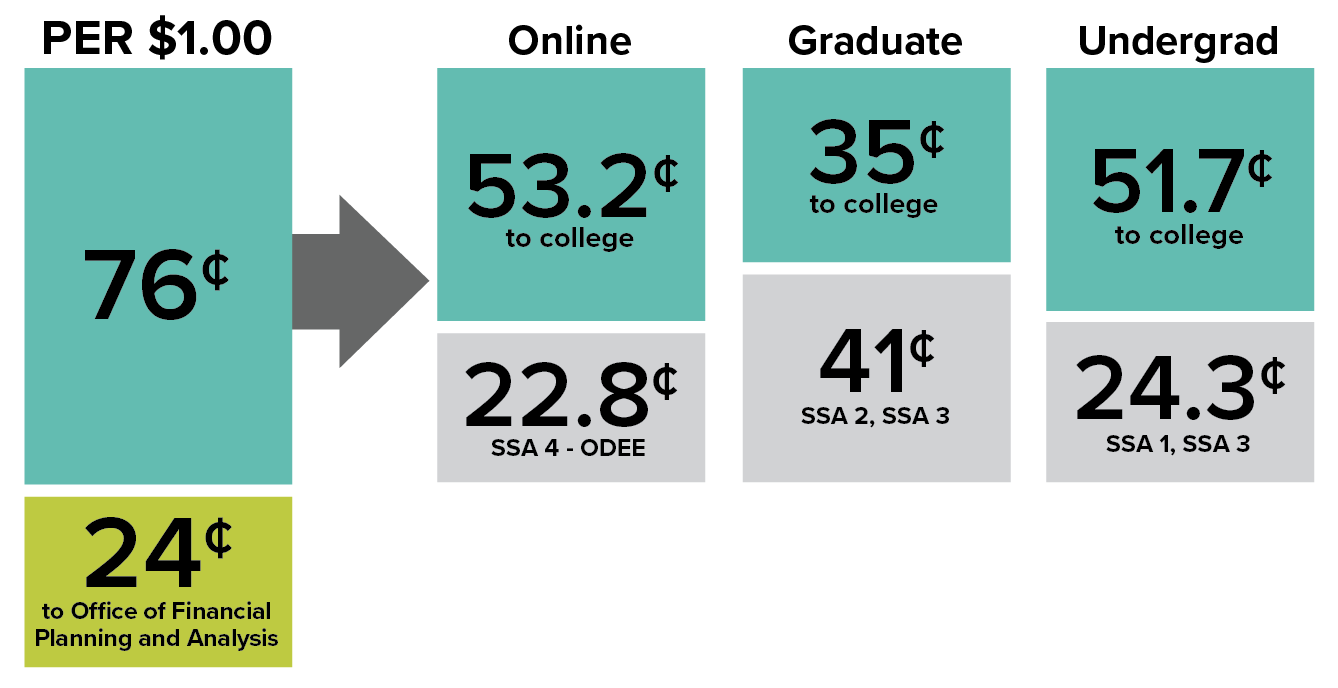
Instead, online programs are charged SSA 4, which funds ODEE’s instructional design and marketing services as well as ongoing program support.
The tables below illustrate the difference in revenue calculation between face-to-face programs and distance education programs.
Revenue Calculation for the average cost of one credit hour in Fiscal Year 2019*
| FACE-TO-FACE PROGRAM | DISTANCE EDUCATION | |
|---|---|---|
| Average Tuition | $1,025.55 | $1,025.55 |
| Average Subsidy | $399.54 | $399.54 |
| Total Revenue | $1,225.32 | $1,225.32 |
| Support Unit Tax | $294.08 (24%) | $294.08 (24%) |
| Net Marginal Revenue | $931.24 | $931.24 |
| SSA2 Charge | $492.26 | NA |
| SSA3 Charge | $4.36 | NA |
| SSA4 DE Assessment | NA | $279.37 |
| Revenue to College | $434.62 (47%) | $651.87 (70%) |
*Since the university does not receive subsidy for out-of-state students, this example is conservative, estimating 50% of subsidy to account for out-of-state students. On average about 80% of online program students are in-state residents.
| FACE-TO-FACE PROGRAM | DISTANCE EDUCATION | |
|---|---|---|
| Average Tuition | $390.84 | $390.84 |
| Average Subsidy | $218.27 | $218.27 |
| Total Revenue | $499.98 | $499.98 |
| Support Unit Tax | $119.99 (24%) | $119.99 (24%) |
| Net Marginal Revenue | $397.98 | $397.98 |
| SSA1 Charge | $118.12 | NA |
| SSA3 Charge | $4.36 | NA |
| SSA4 DE Assessment | NA | $114.00 |
| Revenue to College | $257.50 (68%) | $265.98 (70%) |
*Since the university does not receive subsidy for out-of-state students, this example is conservative, estimating 50% of subsidy to account for out-of-state students. On average about 80% of online program students are in-state residents.
Your unit’s fiscal officer can model a projection for your program using our budget model template.
Process
Online Program Development Process
This list outlines what steps colleges take and what approvals must be secured to create a distance education program at Ohio State.
Exploration
- Meet with ODEE to
- Review Graduate School and/or Council on Academic Affairs (CAA) proposal guidelines and past proposals.
Initial Approvals
- Develop and submit your proposal for approval to the appropriate department and college curricular committees.
- Complete ODEE's Memorandum of Understanding and budget projection worksheet.
- Submit your proposal, ODEE MOU, and budget projection worksheet for approval to the Graduate School and/or CAA.
Course Design and Program Development
This stage takes place after initial approvals are secured.
- Meet with ODEE distance education director and relationship strategist to begin course design.
- Submit applicable courses for online delivery and any course revisions to curriculum.osu.edu.
- Meet with ODEE state authorization team to understand the requirements, service, and process for obtaining authorization.
Final Steps
- If applicable, obtain approval from University Senate, Board of Trustees and Ohio Department of Higher Education. (These approvals typically apply to Change of Delivery and New Program proposals.)
- Registrar assigns CIP, CPP, and ONL codes to your program.
- Create application in partnership with Undergraduate or Graduate Admissions.
- After application has been created and is live, ODEE marketing can begin.
Program Administration
- Prepare for application reviews, advising, student support, etc.
- Admit and enroll students, labeling students in the student information system with the Distance Education (ONL) subplan.
- Meet with ODEE for check-in conversation each semester.
- Continue to work with ODEE marketing to share data around prospective students, applications, and program goals and needs.
Program Approval Timelines*
- New Program: 12-18 months
- Change of Delivery: 9-12 months
- Certificate: 6-9 months
*These timelines are estimates. There are many factors that can affect a proposal's timeline to approval. Please note that once a program has been approved, it needs to be added to the university’s systems and an application needs to be created. This process is estimated to take anywhere from 4-8 weeks.
Contact us for more information about developing your online program.
Course Design
ODEE instructional designers work one-on-one with Ohio State Online program faculty and instructors over a semester-long course design collaboration.
During this time, program faculty may also consult with our educational technologists, instructional multimedia specialists, and library specialists. Online programs might include courses previously offered in other modalities alongside brand-new courses unique to the program. Either way, the ODEE instructional design team supports online program faculty throughout every phase of the design process. Collaboration typically happens through weekly meetings and requires a time commitment from the instructor between meetings to organize materials and create new content.
Envisioning and Planning the Course
Online courses require different approaches and considerations than in-person courses. Setting aside the “old” and envisioning the “new” isn’t an easy task. On the other hand, creating a new online course affords exciting opportunities for reimagining course structure, student engagement, key topics and skill acquisition. Online program instructors work closely with ODEE instructional designers, turning course materials into stories optimized for online learning environments.
Each semester-long course design collaboration begins with a kickoff meeting, during which online program instructors and ODEE instructional designers brainstorm and prioritize goals. Together, ODEE instructional designers and faculty employ a backward design process to:
- Articulate course outcomes
- Determine assessments for measuring outcomes
- Build a week-by-week learning plan with supporting activities
Throughout this process, online program instructors offer ideas for outcomes, assessment, and activities. ODEE instructional designers then collaboratively develop these ideas using evidence-based effective practices for online teaching. Together, the online program instructor and the instructional designer generate a course design plan that takes advantage of online learning environments and guides students to success.
Building the Course
CarmenCanvas, Ohio State’s learning management system, is the hub for online courses and learning experiences. ODEE has created a Carmen course template that is easily navigable and visually appealing by using modules. Each module offers specific content templates for lecture materials and various assignment types. ODEE instructional designers work with instructors to customize this template based on each course’s design plan. Every Carmen course template also includes a customizable online syllabus template for communicating course plans.
There are two goals of each course design collaboration. By the conclusion, we ensure there is a solid course structure within Carmen. More importantly, we empower faculty by imparting skills necessary for course development and maintenance. As such, ODEE instructional designers will connect online program faculty with appropriate professional learning opportunities.
Online program faculty may also receive assistance in creating or curating course content from:
- Educational technologists, who can advise on the best uses of university-supported technology when planning course activities and assignments
- The instructional multimedia team, who can help instructors capture and create audio and visual content
- A library specialist, who can consult on copyright and fair use considerations, locate open educational resources, and support information literacy skills that might be needed in a course
Delivering the Course
Direct ODEE support for new online courses concludes after the semester-long collaboration with an instructional designer. However, the course design process influences how online program faculty deliver their courses, which includes:
- Generating a calendar or checklist of pre-semester and ongoing administrative tasks for the course, and providing links to helpful resources
- Anticipating the instructor workload for designed activities and assessments
- Equipping instructors with knowledge of learning technologies necessary for course maintenance and revisions, such as the addition of weekly overview videos or whole class announcements
Refining the Course
No newly designed online course is 100% perfect on its first iteration. Our instructional design process introduces online program instructors to tools for gathering key data and evaluating a course’s effectiveness. The backward design process generates effective measurements in the form of course assessments that help instructors determine whether course outcomes are being met. Our Carmen template also includes a customizable survey for gathering student feedback throughout the course.
Importantly, this data informs an ODEE-facilitated revision of each course after three years. During this revision, online program faculty are again paired with an ODEE instructional designer who helps brainstorm and execute course updates. If additional support is needed before the three-year mark, online program instructors may request a one-hour consultation.
For more information about teaching online classes at Ohio State, check out ODEE's effective practices for online teaching, or request a consultation.
Marketing
ODEE marketing is responsible for generating demand for Ohio State Online programs and promoting Ohio State Online as a sub-brand of the university.
The ODEE marketing team's goal is to collect prospective student leads using a variety of tactics and drive those leads directly to the college for lead nurturing toward application. An ODEE marketing representative works with leaders from your program and college to design an annual, individualized marketing plan best suited to drive leads to your specific program. It is crucial for each college to participate in these marketing activities to help reach your program's enrollment goals.
ODEE marketing services include:
- A presence on online.osu.edu that includes web development and copywriting (all programs)
- Inclusion in digital and non-digital brand marketing campaigns (all programs)
- Program-specific marketing:
- Tactics that may be employed include digital advertising, traditional advertising, written and visual storytelling, student journey mapping, and landing page development
- Market research insights can be provided to inform program demand, identify competitors, determine alumni outcomes, and more
To contact the distance education marketing team, email osuonline@osu.edu.
Resources
 ODEE offers professional development opportunities and resources for faculty and staff around best practices in online education.
ODEE offers professional development opportunities and resources for faculty and staff around best practices in online education.
Ohio State Online Programs Network
The Ohio State Online Programs Network is for anyone at Ohio State (those with a lastname.#) interested in discussing Ohio State Online programs. Connect with each other, share ideas, and stay up to date on the latest news and research on online program administration, marketing and student support.
The network will have physical and virtual events, but Microsoft Teams is a virtual meeting place to allow for discussions throughout the year. You can join using the link go.osu.edu/online-programs-network if you already use your Ohio State Microsoft Teams account, or you can log in at office365.osu.edu and then click the link. Getting Started materials are linked in the General channel.
Teaching and Learning Resource Center
The Teaching and Learning Resource Center is full of materials to help you make the most of the services we provide. Browse the topics or search for something specific.
Teaching Support Consultations
ODEE provides consultations and support for using teaching strategies that incorporate or rely on technology. Consultations start with reaching a shared understanding of your current goals and motivations. From there, we'll explore specific strategies for choosing learning technology tools.
Virtual Course Components Scheduling Job Aid
Are you looking for clarity about the differences between virtual course modes at Ohio State, how virtual courses should be scheduled, and how to communicate attendance expectations to students? The Virtual Course Components Scheduling Job Aid lays out the differences between modes and details considerations for scheduling online and hybrid courses.
Workshops
Attendees can ask questions and work directly with staff from ODEE at various workshops throughout the year. Workshop topics focus on ODEE's major toolset resources and additional learning technology offerings. Explore our upcoming workshops and register online. You can also subscribe to our newsletter.
Still need help? Reach out to us! You can expect to hear back in 1-2 business days.
Virtual Course Components Scheduling Job Aid
Hybrid (HY), Distance Enhanced (DH), and Distance Learning (DL) courses all leverage technology to deliver formalized instruction. A key decision for instructors is to determine whether students will be required to attend the virtual component of the course at a specific time (synchronously) or at a time of their own choosing (asynchronously) when not meeting in-person. Instructors can find delivery mode planning strategies in the Teaching and Learning Resource Center.
It is critical instructors convey any synchronous virtual attendance expectations for the term—whether for one session (such as a final assessment), for a few sessions or repeated sessions—to course schedulers, the Registrar’s Office, advisors, and most importantly, to students.
Indicating all synchronous attendance requirements, both in-person and virtual, in the Student Information System helps students plan their schedules and affords advisors the opportunity to support student success and guide both students and instructors toward resources for navigating a multi-modal learning and teaching experience. Read more about synchronous and asynchronous learning.
For more information on Ohio State's class labels, view the University Registrar's Job Aid for Class Labels.
| Mode of delivery | % virtual Instruction | Student Attends in-Person | Scheduling considerations for student and instructor success | On-Campus Fees Assessed?* |
|---|---|---|---|---|
| Hybrid (HY) | 25-74% | Consistent cadence throughout the term | 1. Specific time, day, and campus location for in-person instruction 2a. Specific time (typically the same as in-person meetings), day, and online "location" for real-time (synchronous) virtual instruction or 2b. No specific time, day, or location necessary for virtual instruction if occurring on students' own schedule (asynchronous) | Yes |
| Distance-Enhanced (DH) | 75-99% | A few, limited times per term | 1. Specific time, day, and campus location for in-person instruction 2a. Specific time (typically the same as in-person meetings), day , and online "location" for real-time (synchronous) virtual instruction or 2b. No specific time, day, or location necessary for virtual instruction if occurring on students' own schedule (asynchronous) | Yes |
| Distance Learning (DL) | 100% | Never | 1. Specific time, day, and online "location" for real-time virtual instruction (synchronous) or 2. No specific time, day, or location necessary if all virtual instruction is occurring on students' own schedule each week (asynchronous) | No** |
*Applies to students enrolled in a campus-based program as their primary Career Program Plan
**When all student's schedule has all DL courses, distance education fees and surcharges will be assessed, regardless of campus.
Examples and Recommendations for Course Schedulers
Create new course sections for each delivery mode intended to be offered for the term. For example, if some students attend entirely online, while others attend in-person, students should enroll in whichever mode—either distance learning (DL) or in-person (P)—reflects their actual participation. An instructor may be assigned to two sections during the same day and time; however, a course section for a particular delivery mode should not be created solely for one-off accommodations. Work with Student Life Disability Services for particular student accommodations.
Hybrid (HY)
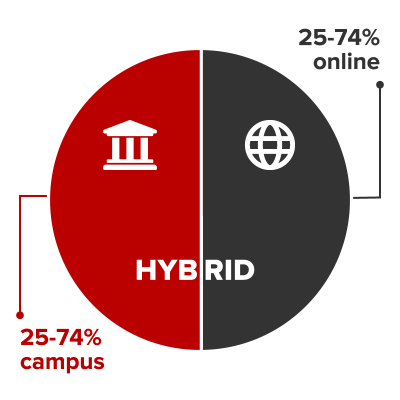 In a Hybrid course, 25% to 74% of formalized instruction for each student is provided through distance learning. The remainder of formalized instruction is provided through required on-campus attendance.
In a Hybrid course, 25% to 74% of formalized instruction for each student is provided through distance learning. The remainder of formalized instruction is provided through required on-campus attendance.
Hybrid Course Examples
- Weekly in-person meeting(s) + weekly scheduled Zoom course session(s)
Enter the weekly classroom meeting(s), with location, as well as the scheduled Zoom meetings, with online indicated as the location. - Weekly in-person meeting(s) + weekly Carmen learning
Enter the weekly classroom meeting(s), with location. Instructors and advisors will help explain to students that remainder of direct instruction will occur asynchronously through Carmen; that is, no specific virtual meeting times or days are required of the students. - Pattern of weekly in-person meetings subdivided by student “cohort” + weekly online learning
Weekly in-person meetings, based on a standard meeting pattern, where smaller sub-cohorts of students each attend only one of the meetings each week. Note: Because of difficulties related to clearly communicating to students when to attend class in person, these “cohort” classes should, when possible, be scheduled as separate HY sections so students see only the scheduled meetings they are meant to attend. Sections can be combined in Carmen. If students are to attend via Zoom on days they are not in the classroom—as opposed to completing their online work solely through Carmen—students should see each of those remote meetings scheduled, with location as online, along with the in-person meeting. When not using separate sections, some units leverage Carmen Groups tools for students to select their “cohort” group and determine their in-person attendance day. - Hybrid approach (one of the above) or in-person class with option for entirely remote participation
The specific structure selected by the instructor for a “simulcast” or HyFlex (hybrid-flexible) approach, where some students attend class in person while others attend online, or where students have the option to choose each day how to attend, should be communicated clearly in the schedule notes, as well as in the course syllabus. Virtual instruction times should be identified with location as online. The Student Information System itself does not provide any straightforward way to communicate this arrangement. It is recommended to provide separate sections, one in-person (P) and one distance learning (DL), because students pay on-campus fees if the class is labeled as hybrid (HY), even if they attend fully online throughout the term.
Distance Enhanced (DH)
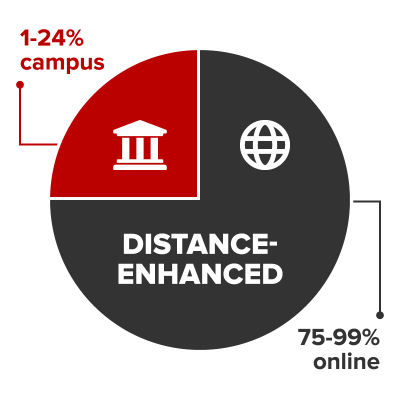 In a Distance Enhanced course, 75% to 99% of formalized instruction is provided through distance learning. The remainder of formalized instruction is provided through required on-campus attendance.
In a Distance Enhanced course, 75% to 99% of formalized instruction is provided through distance learning. The remainder of formalized instruction is provided through required on-campus attendance.
Distance Enhanced Course Examples
- Weekly online learning in Carmen + less frequent in-person meetings
Enter the scheduled classroom meetings, with location. Indicate in notes that most of the instruction will occur online through Carmen. Instructors and advisors will explain that remainder of direct instruction will occur asynchronously through Carmen. - Weekly Zoom class sessions most weeks + less frequent in-person meetings
Enter the scheduled Zoom meetings, with location as online, as well as the scheduled classroom meetings, with their locations. If applicable, instructors and advisors will help to explain that remainder of direct instruction will occur asynchronously through Carmen.
Distance Learning (DL)
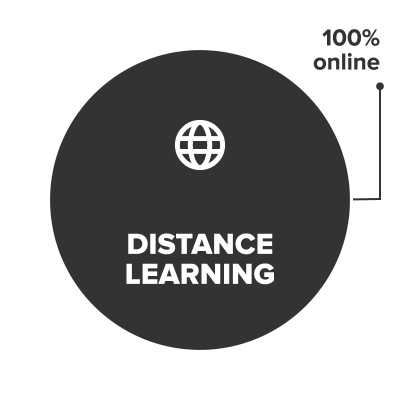 In a Distance Learning course, 100% of formalized instruction occurs via distance learning with no required in-person components and no specified days or times for formalized instruction.
In a Distance Learning course, 100% of formalized instruction occurs via distance learning with no required in-person components and no specified days or times for formalized instruction.
Distance Learning Course Examples
- Weekly online learning in Carmen with no scheduled meetings
Indicate location as online but without scheduled meetings. Instructors and advisors will help to explain that direct instruction will occur asynchronously through Carmen. - Weekly online learning in Carmen + weekly (or other pace) scheduled Zoom meetings
Enter required Zoom sessions as scheduled meetings, with location listed as online. Instructors and advisors will help to explain that remainder of direct instruction will occur asynchronously through Carmen.
Questions?
If you're still not sure what mode and course details are appropriate for a given course, contact your college or campus associate dean for curriculum or the person responsible for entering your course information into the Student Information System.